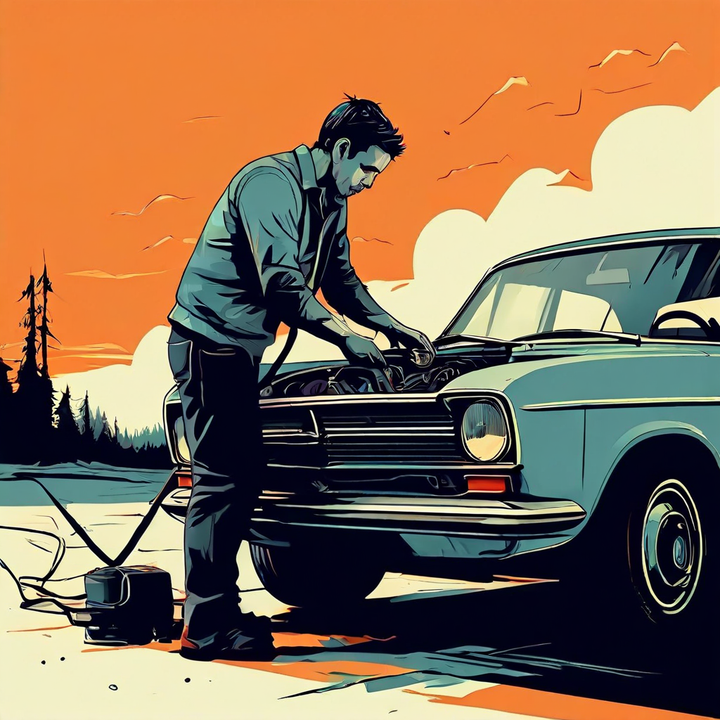


Having your car shut off unexpectedly while driving can be a frightening and potentially dangerous experience. This issue, where the car shuts off but then starts back up again, is a relatively common problem that can stem from various underlying causes. It's crucial to identify and address the root cause promptly to ensure safe driving conditions and prevent further damage to the vehicle.

Over the years, I've learned that the root cause of this issue often lies within the fuel system. The fuel pump, a vital component responsible for delivering the correct amount of fuel to the engine at the right pressure and intervals, is frequently the culprit. When this pump fails, it can lead to intermittent fuel starvation, causing the engine to stall and then restart once fuel flow is restored.
Another common culprit is a clogged fuel filter. This filter's primary function is to remove contaminants from the fuel before it reaches the engine. However, when it becomes excessively clogged, it can restrict fuel flow, leading to the same stalling and restarting behavior.
While fuel system issues are the most prevalent causes, other potential factors can contribute to this problem. Electrical issues, such as a weak battery or a failing alternator, can disrupt the engine's power supply, causing it to shut off temporarily. Ignition system problems, like worn spark plugs or faulty ignition coils, can also lead to misfiring and stalling. Additionally, engine overheating or sensor malfunctions can trigger this issue in some cases.
When faced with this problem, I always recommend following a systematic troubleshooting approach. First and foremost, check your fuel level and refill if it's low. Running out of gas is an obvious cause, but it's often overlooked in the heat of the moment.
Next, listen carefully for any unusual noises coming from the fuel pump when the engine is running. A whining or buzzing sound could indicate a failing pump. Additionally, check if the "Check Engine" light is illuminated, as this could point to sensor or electrical issues. An OBD2 scanner can help read any trouble codes and provide valuable diagnostic information.
Inspect the air filter for clogs, as restricted airflow can also cause stalling. Look for any leaks or damage in the fuel lines, which could lead to fuel starvation. And don't forget to check for signs of overheating, such as a rising temperature gauge or steam from the engine bay.
Once you've identified the root cause, it's time to address the issue. If the fuel pump is the culprit, a replacement is necessary. This process involves disconnecting the battery, draining the fuel tank, removing the fuel pump assembly, and installing a new pump and filter. After refilling the tank and priming the fuel system, your vehicle should be back in top shape.
If the fuel filter is clogged, simply locate it (typically under the hood or near the fuel tank) and replace it with a new one, following the manufacturer's instructions.
In the case of electrical issues, you may need to replace a dead battery or a faulty alternator to restore proper electrical supply. For ignition system problems, worn spark plugs, ignition coils, or wires may need to be replaced to ensure proper ignition.
If faulty sensors are the cause, a mechanic may need to replace components like the crankshaft position sensor or oxygen sensor.

While repairs are necessary in some cases, prevention is always better than cure. I strongly recommend following the manufacturer's recommended maintenance schedule for fuel system components, filters, spark plugs, and other wear items. Regular maintenance can help identify and address potential issues before they escalate.
Additionally, check and replace your battery every 3-5 years to prevent electrical issues. Regularly inspect hoses, belts, and wiring for any damage or corrosion, and address any engine overheating issues promptly to prevent further damage.
Using high-quality fuel and keeping your tank at least 1/4 full can also help prevent sediment buildup and fuel system issues. And remember, addressing any underlying problems promptly can save you from more costly repairs down the line.
When it comes to the cost of repairs, it can vary depending on the specific issue and the make/model of your vehicle. However, here are some approximate costs for common repairs:
Fuel Pump Replacement: $300 - $800 including parts and labor
Fuel Filter Change: $50 - $150
Battery Replacement: $100 - $300
Alternator Replacement: $400 - $800
Spark Plug Replacement: $100 - $300
Oxygen Sensor Replacement: $200 - $500
Ignition Coil Replacement: $150 - $400
While these costs may seem daunting, it's important to remember that addressing the issue promptly can prevent further damage and ensure the safe operation of your vehicle.
In conclusion, if your car shuts off while driving but starts back up, don't panic. With the right knowledge and approach, this issue can be resolved. As a mechanic, I've seen countless cases like this, and I understand the frustration and concern it can cause. However, by following the troubleshooting steps, repair instructions, and preventive measures outlined in this article, you can get back on the road safely and with peace of mind.
Remember, having a professional mechanic diagnose and repair the issue is always recommended to avoid further damage and ensure proper and safe operation of your vehicle. Trust me, it's better to address the problem head-on than to risk being stranded or putting yourself in danger.
So, the next time your car shuts off unexpectedly, take a deep breath, and approach the situation with confidence. With the right knowledge and a little elbow grease, you'll be back on the road in no time.
A whining or buzzing noise from the fuel tank area when the engine is running, and difficulty starting the engine are signs of a failing fuel pump.
Check if the "Check Engine" light is on, or if there is a noticeable drop in fuel efficiency and engine performance over time.
Yes, a weak or dead battery can disrupt the electrical supply to the engine components, leading to stalling while driving.
A failing alternator cannot properly recharge the battery, leading to electrical issues that can cause the engine to stall and restart.
Use an OBD2 scanner to read any trouble codes related to the ignition system, or check for signs of misfiring or rough idling.
Yes, a severely clogged air filter can restrict airflow to the engine, causing it to stall and potentially restart once the airflow is restored.
Rising temperature gauge readings, steam from the engine bay, and a hot engine smell are all signs of overheating that can lead to stalling.
It's generally recommended to replace the battery every 3-5 years to prevent electrical issues and potential stalling.
Yes, using low-quality fuel can lead to sediment buildup and fuel system issues, potentially causing the engine to stall while driving.
No, it's not safe to continue driving if your car keeps stalling, as it can put you and others at risk. It's best to have the issue diagnosed and repaired by a professional mechanic.

Sarah isn't your average gearhead. With a double major in Mechanical Engineering and Automotive Technology, she dived straight into the world of car repair. After 15 years of turning wrenches at dealerships and independent shops, Sarah joined MICDOT to share her expertise and passion for making cars run like new. Her in-depth knowledge and knack for explaining complex issues in simple terms make her a valuable asset to our team.











